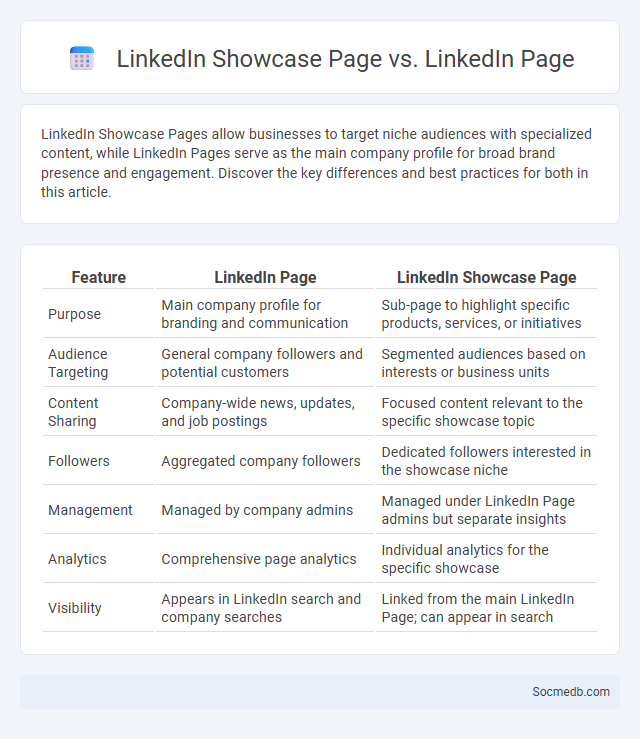
Photo illustration: LinkedIn Showcase Page vs LinkedIn Page
LinkedIn Showcase Pages allow businesses to target niche audiences with specialized content, while LinkedIn Pages serve as the main company profile for broad brand presence and engagement. Discover the key differences and best practices for both in this article.
Table of Comparison
| Feature | LinkedIn Page | LinkedIn Showcase Page |
|---|---|---|
| Purpose | Main company profile for branding and communication | Sub-page to highlight specific products, services, or initiatives |
| Audience Targeting | General company followers and potential customers | Segmented audiences based on interests or business units |
| Content Sharing | Company-wide news, updates, and job postings | Focused content relevant to the specific showcase topic |
| Followers | Aggregated company followers | Dedicated followers interested in the showcase niche |
| Management | Managed by company admins | Managed under LinkedIn Page admins but separate insights |
| Analytics | Comprehensive page analytics | Individual analytics for the specific showcase |
| Visibility | Appears in LinkedIn search and company searches | Linked from the main LinkedIn Page; can appear in search |
Introduction to LinkedIn Page Types
LinkedIn offers various page types designed to cater to different professional needs, including Personal Profiles, Company Pages, and Showcase Pages. Personal Profiles highlight individual expertise and networking opportunities, while Company Pages allow businesses to promote their brand and share updates. Showcase Pages serve as extensions of Company Pages, focusing on specific products, services, or initiatives to engage targeted audiences effectively.
What is a LinkedIn Page?
A LinkedIn Page is a professional profile designed for businesses, organizations, or institutions to showcase their brand, share updates, and engage with followers on LinkedIn. Your LinkedIn Page serves as a hub for posting company news, job opportunities, and industry insights that attract potential clients, employees, and partners. By optimizing your LinkedIn Page with relevant keywords and rich content, you can enhance brand visibility and establish authority in your industry.
What is a LinkedIn Showcase Page?
A LinkedIn Showcase Page is a subpage of your main LinkedIn Company Page designed to highlight a specific brand, product, or initiative. It allows you to tailor content and target a niche audience, enhancing engagement and brand visibility. You can use Showcase Pages to build deeper connections by sharing relevant updates that resonate with your specialized followers.
Key Differences: LinkedIn Page vs Showcase Page
LinkedIn Pages serve as the main profile for businesses, allowing you to share company updates, post job opportunities, and engage with followers broadly. Showcase Pages function as extensions of LinkedIn Pages, designed to spotlight specific products, services, or initiatives, offering targeted content to niche audiences. Your choice between these depends on whether you want to promote overall brand identity or highlight particular business aspects to specialized followers.
Benefits of Using LinkedIn Pages
LinkedIn Pages enhance brand visibility by allowing businesses to present professional content directly to a targeted audience of industry professionals and potential clients. Companies can leverage analytics tools on LinkedIn Pages to monitor engagement, refine marketing strategies, and optimize content for improved outreach. These pages also facilitate networking opportunities by connecting organizations with talent pools, partners, and industry influencers, driving business growth and recruitment efforts.
Advantages of LinkedIn Showcase Pages
LinkedIn Showcase Pages enhance brand visibility by targeting specific audience segments, allowing companies to tailor content for niche markets and increase engagement. They provide advanced analytics that help marketers track user interactions and optimize content strategies based on performance data. These pages also improve content discoverability through SEO benefits within LinkedIn's professional network, driving higher-quality leads and fostering meaningful business connections.
Ideal Use Cases for LinkedIn Pages
LinkedIn Pages are ideal for B2B companies aiming to showcase industry expertise, share professional content, and engage decision-makers. They support talent acquisition by highlighting company culture and job opportunities to attract qualified candidates. Businesses can leverage analytics from LinkedIn Pages to refine marketing strategies and build a trusted brand presence within their target professional network.
When to Choose a Showcase Page
Choose a LinkedIn Showcase Page when targeting a specific audience or promoting a distinct product line separate from your main brand identity. This option enhances content relevance by allowing tailored messaging that resonates with unique customer segments. Showcase Pages are ideal for businesses aiming to highlight specialized services, increase engagement, and track performance metrics independently from their primary company page.
Best Practices for Managing Both Page Types
Effective management of both personal and business social media pages requires consistent content scheduling, audience engagement, and analytics review to maximize reach and interaction. Tailoring your messaging to fit the platform's unique audience and leveraging tools like social media management software can streamline your efforts and enhance performance. Prioritize authentic communication and regular monitoring to ensure your social media presence supports your overall brand goals and responds promptly to user feedback.
LinkedIn Page vs Showcase Page: Which Is Right for Your Business?
LinkedIn Pages provide a comprehensive platform for your entire business brand, enabling broad content sharing and audience engagement, while Showcase Pages allow targeted messaging for specific products, services, or market segments associated with your company. Choosing between a LinkedIn Page and a Showcase Page depends on your marketing goals, audience segmentation, and the need for specialized communication channels. To maximize your LinkedIn strategy, assess whether you need a unified brand presence or distinct spaces for different aspects of your business to connect effectively with your target audience.
 socmedb.com
socmedb.com